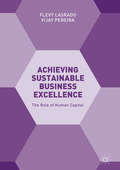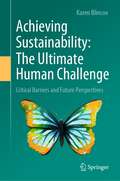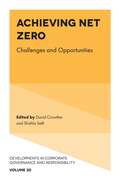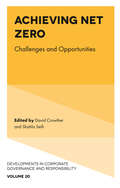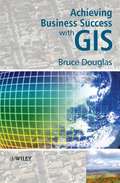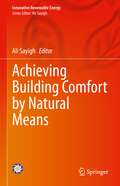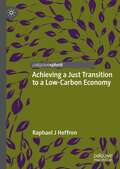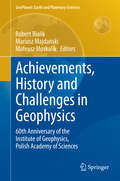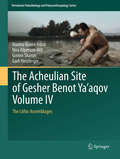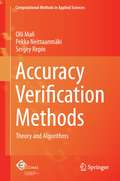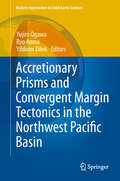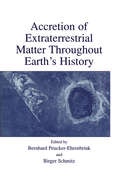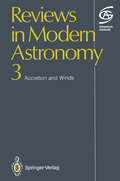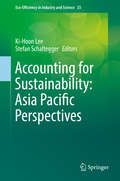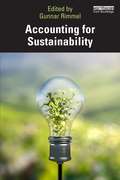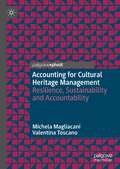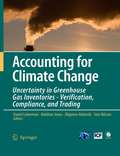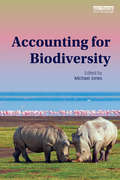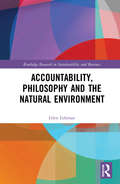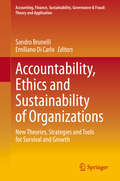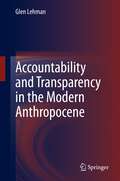- Table View
- List View
Achieving Sustainable Business Excellence: The Role of Human Capital
by Vijay Pereira Flevy LasradoCompiling the best practices of business excellence frameworks around the world, this new book addresses the need for innovative research on sustainable business performance. Using detailed empirical studies, the authors outline the motives and benefits of the implementation of such frameworks in different geographical regions. Comprehensive case studies showcase how the variety of excellence frameworks are manifested in their work cultures, values and beliefs. Academics studying quality management, HRM, and international business will find this book an essential read as it establishes the relevance of human capital in achieving and sustaining global business excellence.
Achieving Sustainable Business Excellence: The Role of Human Capital
by Vijay Pereira Flevy LasradoCompiling the best practices of business excellence frameworks around the world, this new book addresses the need for innovative research on sustainable business performance. Using detailed empirical studies, the authors outline the motives and benefits of the implementation of such frameworks in different geographical regions. Comprehensive case studies showcase how the variety of excellence frameworks are manifested in their work cultures, values and beliefs. Academics studying quality management, HRM, and international business will find this book an essential read as it establishes the relevance of human capital in achieving and sustaining global business excellence.
Achieving Sustainability: Critical Barriers and Future Perspectives
by Karen BlincoeThe book provides an assessment of whether sustainability is realizable in the current societal framework. What are the challenges and the barriers - and what are the levers necessary to meet and overcome them?Through a revision of the essence of sustainability the book provides an opportunity to understand the deeper level of the radical change that sustainability represents, and the resistance that is preventing its realization.To build the argument the sustainable development model is compared with current development theories as well as alternative solutions based on utopian models of the past. The book assesses the results that can be achieved within the current systemic framework, based on case stories. It outlines the limitations to sustainability, pointing out and defining the multiple, cross-sectoral and systemic barriers that hinder the transition.Finally, the book offers perspectives on achieving a sustainable future, encompassing the impacts from recent events including the pandemic as well as the multiple mitigation and transition initiatives undertaken globally.Brian Goodwin's QuoteLike the caterpillar that wraps itself up in its silken swaddling bands prior to its metamorphosis into a butterfly, we have wrapped ourselves in a tangled skin from which we can emerge only by going through a similarly dramatic transformation.
Achieving Net Zero: Challenges and Opportunities (Developments in Corporate Governance and Responsibility #20)
by David Crowther Shahla SeifiIt is generally accepted that climate change is happening and that steps need to be taken to alleviate this. One action which has become prominent is that of achieving net zero, which has been interpreted in terms of emissions of CO2 and other gases. Net zero cannot be achieved by anyone, any organization or even any country acting alone: a great number of actions need to be taken by individuals and organisations and these will differ according to their location and the nature of the organization involved. Achieving Net Zero brings together chapters to examine these challenges from a range of perspectives, various regions and industries, each presenting unique outlooks. From steps on the journey to net zero and sustainability rhetoric, to case studies in Angola and Mauritius, this edited collection helps facilitate best practice that can be adopted on a global scale. Developments in Corporate Governance and Responsibility offers the latest research on topical issues international experts and has practical relevance to business managers.
Achieving Net Zero: Challenges and Opportunities (Developments in Corporate Governance and Responsibility #20)
by David Crowther and Shahla SeifiIt is generally accepted that climate change is happening and that steps need to be taken to alleviate this. One action which has become prominent is that of achieving net zero, which has been interpreted in terms of emissions of CO2 and other gases. Net zero cannot be achieved by anyone, any organization or even any country acting alone: a great number of actions need to be taken by individuals and organisations and these will differ according to their location and the nature of the organization involved. Achieving Net Zero brings together chapters to examine these challenges from a range of perspectives, various regions and industries, each presenting unique outlooks. From steps on the journey to net zero and sustainability rhetoric, to case studies in Angola and Mauritius, this edited collection helps facilitate best practice that can be adopted on a global scale. Developments in Corporate Governance and Responsibility offers the latest research on topical issues international experts and has practical relevance to business managers.
Achieving Business Success with GIS
by Bruce DouglasWritten at a practical level, suited to the business audience, this exceptional book explores the business environment of making GIS successful. It applies academic rigor to practical and commercial implementation issues and offers viewpoints from all parties involved in GIS implementation. Achieving Business Success with GIS provides tangible advice ranging from technical and financial to organizational and commercial. It is unique in that it does not stop short of providing, without hype or embellishment, practical advice and real examples regarding the total cost of ownership of a project or finance and return investment of GIS products. Achieving Business Success with GIS highlights that the use of GIS technology needs to be focused on the business issues, not the technology. The book begins by describing the use of GIS in a global context within a business environment as the background to outlining the need for organizations to have a strategy for their GIS. The book then goes on to explore the elements of a GIS strategy and explains issues which are relevant for such approaches and how to go about developing it. In the closing chapters of this book, the process of specifying and tendering for a GIS are discussed to ensure that the focus of the reader remains on the business issues of the organization. This is followed by examples of the best and worst Geographic Information Systems including a discussion on Google Earth and Web 2.0. The combination of the statistics from the GIS / Spatial surveys and the author’s consulting experiences make this book an invaluable resource for GIS managers in government (federal, state and local) and utilities, organisations using GIS, and students and lecturers in this field.
Achieving Building Comfort by Natural Means (Innovative Renewable Energy)
by Ali SayighAchieving Building Comfort by Natural Means explores examples of green building designs and methods that are currently being used around the world to achieve human comfort in buildings. The operation of buildings accounts for more than 40% of total energy use and is a major source of carbon emissions. It is imperative that this consumption be substantially decreased and that energy needed for building comfort is obtained from renewable and environmentally friendly sources. This book brings together a global group of contributors who look at factors such as location, climate, building materials, energy management, ventilation, thermal environmental conditions, shading, lighting, acoustics, and more that are critical for achieving buildings that are more sustainable.Thermal comfort and climatic potential of ventilative cooling in Italian climates is available open access under a Creative Commons Attribution 4.0 International License via link.springer.com.
Achieving a Just Transition to a Low-Carbon Economy
by Raphael J HeffronThe ambition of most countries across the world is to develop a low-carbon economy, evidenced by the fact that the vast majority of countries have signed the Paris COP21 agreement. This book contends that this global societal transition to a low-carbon economy must be just. As such, it will be an invaluable and accessible reference for scholars from all research disciplines who aim in their research to see a fairer, more equitable and inclusive world where sustainability is at the fore and climate targets are achieved.This is the first in-depth and original analysis to explore the central importance of law in achieving a just transition to a low-carbon economy. In addition, it advances the JUST framework, a unique framework for assessing the just transition. This important research and theoretical tool provides a practical perspective as it ensures the geographical space and timelines of development are factored into analysis. The research also provides analysis on the just transition movement around the world and the influence of international institutions.Through several case studies on Just Transition Commissions and Critical Mineral Development, the book details and demonstrates key elements of justice, including distributive, procedural, restorative, recognition, and cosmopolitan justice. It is clear from the analysis that while these are vast areas for analysis, if applied in practice, they all centrally contribute to ensuring society will advance in achieving a just transition to a low-carbon economy.
Achievements, History and Challenges in Geophysics: 60th Anniversary of the Institute of Geophysics, Polish Academy of Sciences (GeoPlanet: Earth and Planetary Sciences)
by Robert Bialik Mariusz Majdański Mateusz MoskalikOver the last six decades, the field of geophysics has experienced rapid development. Seismic methods, magnetic studies, hydrology and atmospheric sciences have expanded thanks to a boom in the computer sciences and measurement techniques. The frontiers of geophysics have also expanded, now including research on the polar areas, both Arctic and Antarctic. All these events are clearly reflected in the 60-year-long history of the Institute of Geophysics, Polish Academy of Sciences. This volume describes the most prominent achievements, the history of research and also the future potential of the Institute of Geophysics PAS. It describes measurements in various projects, methods of interpreting scientific data, and last but not least the people who have driven this research in many scientific projects.
The Acheulian Site of Gesher Benot Ya‘aqov Volume IV: The Lithic Assemblages (Vertebrate Paleobiology and Paleoanthropology)
by Naama Goren-Inbar Nira Alperson-Afil Gonen Sharon Gadi HerzlingerThis manuscript is the 4th Volume of the Gesher Benot Ya‘aqov (GBY) monograph sub-series. The goal of the book is to publish the lithic assemblages originating in the excavations of the Acheulian site at Gesher Benot Ya‘aqov (GBY), Israel. The authors provide the readers with detailed descriptions of the lithic assemblages, illustrations (maps, photographs, drawings) and complete inventory of the artifacts that were excavated during the seven field seasons of 1989-1997 (two in 1997) under the directorship of Prof. Naama Goren-Inbar. This manuscript includes the classification of Large Cutting Tools (bifaces: handaxes and cleavers), Cores and Core Tools, and Flake Tools made of three different raw materials (flint, basalt and limestone). This major classification system enables, in addition to the characterization of the assemblages, intra and inter assemblage analyses and comparisons. It forms the foundation and means with which the GBY cultural sequence can be investigated and compared with other Levantine, African and Asian Acheulian entities. From a methodological perspective the authors apply a detailed attribute analysis to all lithic items, a method that integrates morpho-technoogical and stylistic observations culminating in better understanding of the Acheulian realm as documented by the analysis. This analysis is aimed to refine and improve the understanding beyond that of types and their technology and to allow describing the reduction sequence (chaîne opératoire) of some of the major components of the lithic asemblages. The unique record of diverse data from GBY provides insight into hominin behavior (through time) along the margins of the paleo-Lake Hula, and sheds light on processes that led to the colonization of other parts of Eurasia. The book will be of interest to academics and students in all disciplines of Quaternary studies, and to archaeologists using GIS for intra-site spatial analysis.
Accuracy Verification Methods: Theory and Algorithms (Computational Methods in Applied Sciences #32)
by Olli Mali Pekka Neittaanmäki Sergey RepinThe importance of accuracy verification methods was understood at the very beginning of the development of numerical analysis. Recent decades have seen a rapid growth of results related to adaptive numerical methods and a posteriori estimates. However, in this important area there often exists a noticeable gap between mathematicians creating the theory and researchers developing applied algorithms that could be used in engineering and scientific computations for guaranteed and efficient error control. The goals of the book are to (1) give a transparent explanation of the underlying mathematical theory in a style accessible not only to advanced numerical analysts but also to engineers and students; (2) present detailed step-by-step algorithms that follow from a theory; (3) discuss their advantages and drawbacks, areas of applicability, give recommendations and examples.
Accretionary Prisms and Convergent Margin Tectonics in the Northwest Pacific Basin (Modern Approaches in Solid Earth Sciences #8)
by Yujiro Ogawa, Ryo Anma and Yildirim DilekAccretionary prisms in convergent margins are natural laboratories for exploring initial orogenic processes and mountain building episodes. They are also an important component of continental growth both vertically and laterally. Accretionary prisms are seismically highly active and their internal deformation via megathrusting and out-of-sequence faulting are a big concern for earthquake and tsunami damage in many coastal cities around the Pacific Rim. The geometries and structures of modern accretionary prisms have been well imaged seismically and through deep drilling projects of the Ocean Drilling Program (and recently IODP) during the last 15 years. Better understanding of the spatial distribution and temporal progression of accretionary prism deformation, structural and hydrologic evolution of the décollement zone (tectonic interface between the subducting slab and the upper plate), chemical gradients and fluid flow paths within accretionary prisms, contrasting stratigraphic and deformational framework along-strike in accretionary prisms, and the distribution and ecosystems of biological communities in accretionary prism settings is most important in interpreting the evolution of ancient complex sedimentary terrains and orogenic belts in terms of subduction-related processes. This book is a collection of interdisciplinary papers documenting the geological, geophysical, geochemical, and paleontological features of modern accretionay prisms and trenches in the northwestern Pacific Ocean, based on many submersible dive cruises, ODP drilling projects, and geophysical surveys during the last 10 years. It also includes several papers presenting the results of systematic integrated studies of recent to ancient on-land accretionary prisms in comparison to modern analogues. The individual chapters are data and image rich, providing a major resource of information and knowledge from these critical components of convergent margins for researchers, faculty members, and graduate and undergraduate students. As such, the book will be a major and unique contribution in the broad fields of global tectonics, geodynamics, marine geology and geophysics, and structural geology and sedimentology.
Accretion of Extraterrestrial Matter Throughout Earth’s History
by Bernhard Peucker-Ehrenbrink Birger SchmitzEvery year Earth is bombarded with about 40,000 tons of extraterrestrial material. This includes microscopic cosmic dust particles shed by comets and asteroids in outer space, meteorites, as well as large comets and asteroids that have led to catastrophic events in the geologic past. Originally considered only a curiosity, extraterrestrial matter found on Earth provides the only samples we have from comets, asteroids and other planets. Only recently mankind has started to actively collect extraterrestrial matter in space (Apollo program, Stardust mission) rather than to wait for its delivery to Earth. Still, most of our knowledge of the origin and evolution of our solar system is based on careful studies of meteorites, cosmic dust, and traces of large impact events in the geologic record such as the mass extinction that terminated the Cretaceous Period and led to the extinction of the dinosaurs. This book summarizes our current knowledge of the properties, origin, orbital evolution and accretion mechanism of extraterrestrial matter accreted on Earth and sheds light on accretion processes and fluxes in the geologic past. The chapters in the first part of the book are arranged in order to follow extraterrestrial matter from its origin in space, its orbital evolution on its way to Earth, its interaction with the Earth magnetosphere and atmosphere to its more or less violent collision with the Earth's surface. In the second part of the book several chapters deal with the present?day flux of cosmic dust and meteorites to Earth. Finally, several chapters deal with the reconstruction of the accretion history of extraterrestrial matter on Earth, starting with the most recent geologic past and ending with the very early, violent accretion period shortly after the formation of Earth, Moon and other solid planets in our solar system.
Accretion and Winds (Reviews in Modern Astronomy #3)
by Gerhard KlareIn order to bring the scientific events of the meetings of the Astronomische Gesellschaft (AG) to the attention of the worldwide astronomical community, an annual publication, Reviews in Modern Astronomy, was established. It is devoted exclusively to . the invited reviews, the Karl Schwarz schild lectures, and the high light contributions from leading scientists reporting on recent progress and scientific achievements at their respective institutes. This third volume continues the yearbook series of publications of the society. It comprises the complete set of contributions presented during the spring meeting of the AG at Berlin in March 1990, which was dedicated to the topic "Accretion and Winds". In addition four latecomers (two review and two highlight papers) delivered at the fall meeting at Graz, Austria in September 1989 close this volume. Heidelberg, September 1990 G: Klare Contents Some New Elements in Accretion Disk Theory By F. Meyer (With 5 Figures) . . . . . . . . . . . . . . . . . . . . . . . 1 Mass Transfer and Evolution in Close Binaries By A. R. King (With 4 Figures) . . . . . . . . . . . . . . . . . . . . . . . 14 Radiation Hydrodynamics of the Boundary Layer of Accretion Disks in Cataclysmic Variables By W. Kley (With 6 Figures) . . . . . . . . . . . . . . . . . . . . . . . . 21 Curious Observations of Cataclysmic Variables By F. V. Hessman (With 10 Figures) . . . . . . . . . . . . . . . . . . . 32 Accretion in AM Herculis Stars 44 By A. D. Schwope (With 12 Figures) X-ray Diagnostics of Accretion Disks By G. Hasinger (With 12 Figures) . . . . . . . . . . . . . . . . . . . . . 60 Accretion Phenomena at Neutron Stars By A. Rebetzky, H. Herold, U. Kraus, H. -P. Nollert, and H. Ruder (With 13 Figures) . . . . . . . . . . . . . . . . . . . . . .
Accounting for Sustainability: Asia Pacific Perspectives (Eco-Efficiency in Industry and Science #33)
by Ki-Hoon Lee Stefan SchalteggerThis book advances the understanding of corporate sustainability and challenges and roles of sustainability accounting in the Asia-Pacific region. The Asia-Pacific region has shown fast economic growth for several decades which is expected to continue. In this context, Asia has become the “production engine” of the global economy. At the same time scientific reports reveal that some planetary boundaries are crossed, for example relating to biodiversity and climate change. Companies in the Asia-Pacific region are therefore increasingly challenged to reduce their environmental impacts, to document their social contribution and to contribute to sustainable development. Key approaches to identify sustainability problems and challenges, to support improvement processes and to back up sustainability contributions include accounting and reporting. In contrast to the high relevance of accounting and reporting for corporate sustainability for the Asia-Pacific region, academic research has so far been dominated by Western researchers and pre-dominantly dealt with Western and Japanese cases and approaches. It is thus time to take account of Asian perspectives on accounting and reporting for sustainability in the Asia-Pacific region.
Accounting for Sustainability
by Gunnar RimmelThis book provides a broad overview of how sustainability reporting has grown, how it is used now and where it is heading. Daily, we read and hear in various media about concepts such as corporate social responsibility (CSR), sustainability reporting, sustainability accounting, environmental reports, corporate citizenship or environmental management systems. Accounting for Sustainability decodes this terminology by providing an accessible introduction to the topic that explores sustainability reporting from an internal and external perspective. It begins with an overview of how sustainability reporting has emerged and why it is important, before moving on to cover definitions of key terms and specific theories and frameworks. Subsequent chapters explore the role of financial management, sustainability standards, accounting communication and capital markets. With learning outcomes and study questions embedded in each chapter, this book will be of great interest to students of sustainability reporting and accounting, as well as practitioners taking related professional accreditations.
Accounting for Sustainability
by Gunnar RimmelThis book provides a broad overview of how sustainability reporting has grown, how it is used now and where it is heading. Daily, we read and hear in various media about concepts such as corporate social responsibility (CSR), sustainability reporting, sustainability accounting, environmental reports, corporate citizenship or environmental management systems. Accounting for Sustainability decodes this terminology by providing an accessible introduction to the topic that explores sustainability reporting from an internal and external perspective. It begins with an overview of how sustainability reporting has emerged and why it is important, before moving on to cover definitions of key terms and specific theories and frameworks. Subsequent chapters explore the role of financial management, sustainability standards, accounting communication and capital markets. With learning outcomes and study questions embedded in each chapter, this book will be of great interest to students of sustainability reporting and accounting, as well as practitioners taking related professional accreditations.
Accounting for Cultural Heritage Management: Resilience, Sustainability and Accountability
by Michela Magliacani Valentina ToscanoThe transformative role of culture, its ability to create value for the benefit of current and future generations, is widely recognized by academics of many disciplines, professionals and policymakers. Notwithstanding, how culture can be a driving force for economic growth, a source of welfare and tools for social inclusion, still deserves to be investigated at various levels, starting with local communities. This book attempts to explain the relevance of accounting knowledge for managing cultural heritage by sustainable, resilient, accountable organizations, regardless of their public or private institutional form. This book aims at understanding the role of cultural heritage in the economy, in society and in facing the new challenges deriving from the enactment of the UN Sustainable Development agenda, as well as the pandemic emergency from COVID-19. It adopts a managerial accounting studies approach to provide answers that can be applied in any organizational context. The results achieved from the field research are critically discussed under the theoretical frameworks referring to the theory of value and its creation. From the findings and their discussion, a conceptual model based on empiricism is proposed for managing cultural heritage of communities under sustainable perspective, even in times of crisis. It will be essential reading for academics and students of cultural heritage management, sustainability and crisis management in organisations.
Accounting for Climate Change: Uncertainty in Greenhouse Gas Inventories - Verification, Compliance, and Trading
by Daniel Lieberman Matthias Jonas Zbigniew Nahorski Sten NilssonUncertainty analysis is a key component of national greenhouse gases inventory analyses. The issues that are raised by the authors in this volume, and the role that uncertainty analysis plays in many of their arguments and/or proposals, highlight the importance of such efforts. Coverage includes: bottom-up versus top-down emission inventory approaches, compliance and verification issues, and the role of uncertainty in emissions trading schemes.
Accounting for Biodiversity: Accounting For Biodiversity
by Michael Jones‘Biodiversity’ at its simplest, refers to the variety of species inhabiting Planet Earth. It is essential to the well-being of the planet. There is now a scientific consensus around the current ongoing crisis in biodiversity arising from both climate change and human activities. Experts believe we are in the middle of a mass extinction of biodiversity with devastating consequences for our planet. Accounting for Biodiversity explores the need for companies to actively protect, conserve and improve biodiversity within their sphere of operation. The 14 chapters written by a selected team of experts investigate the ways in which companies are embracing their responsibility through a variety of biodiversity initiatives and innovative models designed to improve the recording, reporting and valuing of biodiversity. Global case studies look at biodiversity accounting in Africa, Asia, Australasia, Europe and South America. Overall, this book provides a comprehensive set of reflections on accounting for biodiversity and recommendations for the future. This book is essential reading for all those interested in the contribution that accounting can make to the preservation of biodiversity. As we see increasing awareness of the importance of sustainability and ecological responsibility in business activity it is relevant and should prove informative to students, managers, accountants and those in business more generally. It is also important for all those interested in conserving biodiversity.
Accounting for Biodiversity
by Michael Jones‘Biodiversity’ at its simplest, refers to the variety of species inhabiting Planet Earth. It is essential to the well-being of the planet. There is now a scientific consensus around the current ongoing crisis in biodiversity arising from both climate change and human activities. Experts believe we are in the middle of a mass extinction of biodiversity with devastating consequences for our planet. Accounting for Biodiversity explores the need for companies to actively protect, conserve and improve biodiversity within their sphere of operation. The 14 chapters written by a selected team of experts investigate the ways in which companies are embracing their responsibility through a variety of biodiversity initiatives and innovative models designed to improve the recording, reporting and valuing of biodiversity. Global case studies look at biodiversity accounting in Africa, Asia, Australasia, Europe and South America. Overall, this book provides a comprehensive set of reflections on accounting for biodiversity and recommendations for the future. This book is essential reading for all those interested in the contribution that accounting can make to the preservation of biodiversity. As we see increasing awareness of the importance of sustainability and ecological responsibility in business activity it is relevant and should prove informative to students, managers, accountants and those in business more generally. It is also important for all those interested in conserving biodiversity.
Accountability, Philosophy and the Natural Environment (Routledge Research in Sustainability and Business)
by Glen LehmanUsing a philosophical and interdisciplinary approach, this book looks at how accountability can provide solutions to our current environmental and global political problems. When a social system has external elements imposed upon it, or presented to it, political problems are likely to emerge. This book demonstrates that what is needed are connecting social elements with a natural affinity to bring people together despite their differences. This book is different from others in the field. It provides new insights by critiquing the extant understandings of accountability and expands the possibilities by building on Charles Taylor’s philosophies. Central to the argument of the book are perspectives on authenticity and expressivism which are found to provide a radical reworking of our understanding of being in the world, and a starting point for rethinking the way individuals and communities ought to be dealing politically with accountability and ecological crises. The argument builds to an accountability perspective that utilises work from interpretivism, liberalism, and postmodern theory. The book will be of interest to researchers in environmental philosophy, critical perspectives on accounting, corporate governance, corporate social reporting, and environmental accounting.
Accountability, Philosophy and the Natural Environment (Routledge Research in Sustainability and Business)
by Glen LehmanUsing a philosophical and interdisciplinary approach, this book looks at how accountability can provide solutions to our current environmental and global political problems. When a social system has external elements imposed upon it, or presented to it, political problems are likely to emerge. This book demonstrates that what is needed are connecting social elements with a natural affinity to bring people together despite their differences. This book is different from others in the field. It provides new insights by critiquing the extant understandings of accountability and expands the possibilities by building on Charles Taylor’s philosophies. Central to the argument of the book are perspectives on authenticity and expressivism which are found to provide a radical reworking of our understanding of being in the world, and a starting point for rethinking the way individuals and communities ought to be dealing politically with accountability and ecological crises. The argument builds to an accountability perspective that utilises work from interpretivism, liberalism, and postmodern theory. The book will be of interest to researchers in environmental philosophy, critical perspectives on accounting, corporate governance, corporate social reporting, and environmental accounting.
Accountability, Ethics and Sustainability of Organizations: New Theories, Strategies and Tools for Survival and Growth (Accounting, Finance, Sustainability, Governance & Fraud: Theory and Application)
by Sandro Brunelli Emiliano Di CarloThis book explains how the traditional paradigm of private and public organizations is changing as a result of the multiple factors that are affecting the way in which goods and services are produced, and for whom they are produced. In view of these disruptive trends, the theory of the firm needs to be updated and to some extent rethought. Moreover, diverse challenges and opportunities such as climate change, aging populations, and new public accountability requirements are necessitating novel frameworks to ensure the long-term survival of public and private organizations. Against this backdrop, the authors contribute to the debate over the firm’s primary interest by proposing a new way of viewing the nature of the firm and its relationship with stakeholders. In addition, they carefully analyze the challenges and opportunities mentioned above, evaluating their significance for various important aspects of organizations through different lenses. Global in scope, the book also takes the United Nations Sustainability Development Goals into account. Accordingly, it will be of interest to all readers seeking a better understanding of the evolving nature of firms and organizations in our changing world.
Accountability and Transparency in the Modern Anthropocene
by Glen LehmanThe book is about accountability processes and how they contribute solutions to our current environmental and global political problems. This book is different to other literature in this field. This is so because the dominant accountability discourse is shaped by what is defined as a neoliberal business case for social and environmental reform. This book assumes a nirvana stance within globalisation where all citizens operate within the parameters of the free market and will recover from adverse economic and political damage. Further this book uses neoliberalism and free-market reforms aims as examples to implement efficient management technologies and create more competitive pressures. Central to the argument of the book are perspectives on authenticity, expressivism and interpretivism which are found to provide a radical reworking of our understanding of being in the world. These frameworks offer a starting point for rethinking the way individuals, businesses and communities ought to be dealing politically with accountability and ecological crises. The argument builds to an accountability perspective that utilises work from expressivism, interpretivism, classical liberalism and postmodern theory. The theoretical quest undertaken in this book is to develop connections between accountability, democratic, ethical and ecological perspectives.
